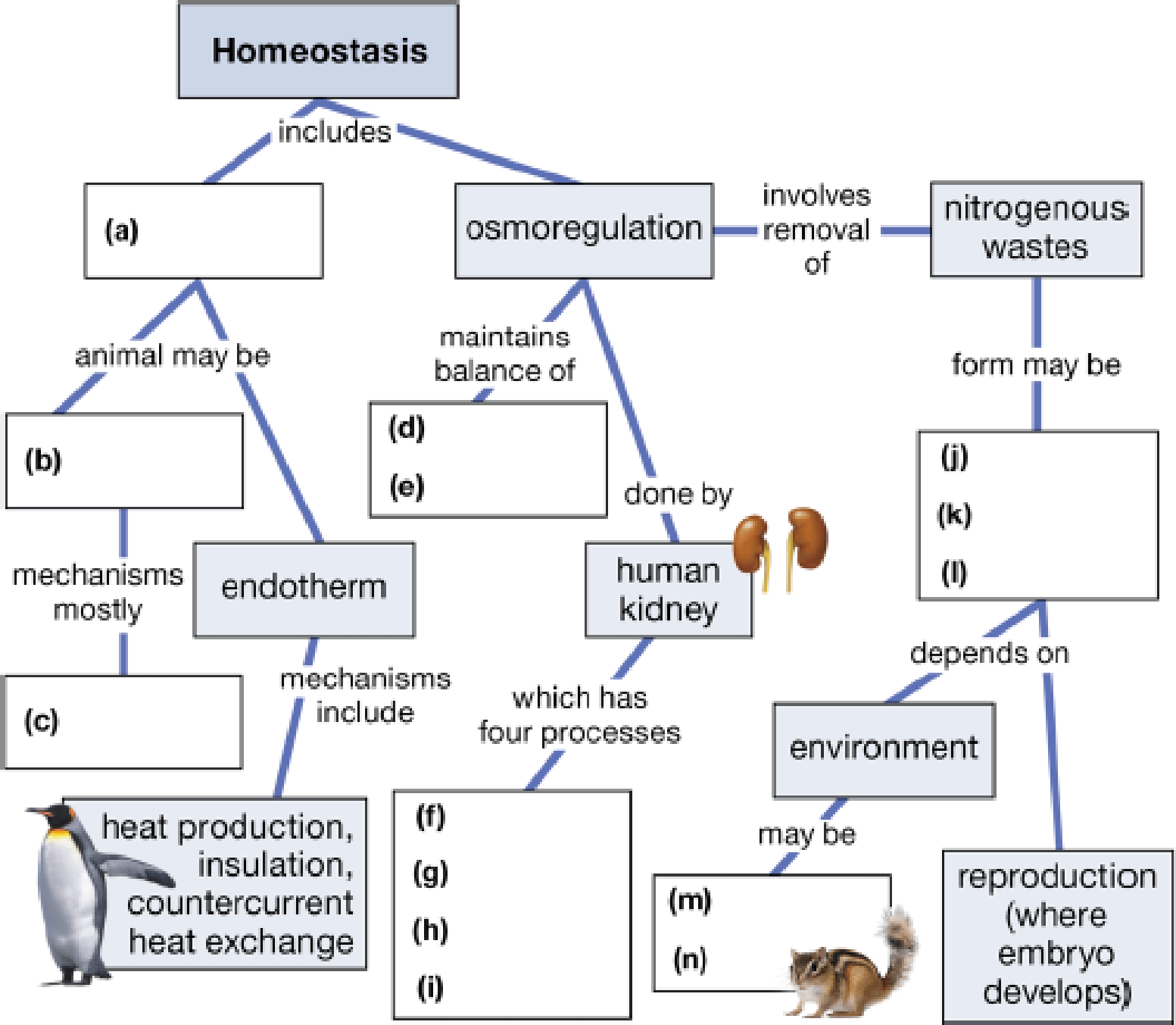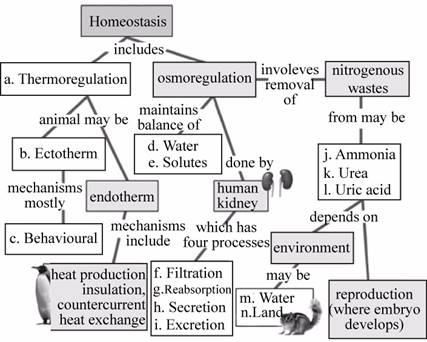
Concept explainers
Complete this map, which presents the three main topics of this chapter.

To complete: The given map representing the three main topics of this chapter.
Concept introduction: The processes such as thermoregulation and Osmoregulation are very essential for maintaining the homeostasis of the body.
The change in constant internal body temperature can impair the activity of enzymes and therefore, can result in death. The disturbance in osmolarity can have similar effects.
Answer to Problem 1CC
Pictorial representation: Fig.1 shows the completed map representing the three main topics of this chapter.

Fig.1: Three main topics of the chapter.
Explanation of Solution
(a)
Correct answer: Thermoregulation
Explanation: Thermoregulation is a homeostatic mechanism in animals that maintains the constant internal body temperature regardless of external temperature fluctuations. Hence the correct answer is thermoregulation.
(b)
Correct answer: Ectotherm
Explanation: Ectotherms are those animals that can regulate their body temperatures by gaining heat from surroundings. Hence, the correct answer is ectotherm.
(c)
Correct answer: Behavioral
Explanation: Ectotherm maintains constant body temperatures by behavioral responses such as huddling, migration and sun bathing. Hence, the correct answer is behavioral response.
(d)
Correct answer: Water
Explanation: The Osmoregulation is a process by which an organism maintains balance of water in the body. Hence, the correct answer is water.
(e)
Correct answer: Solutes
Explanation: The Osmoregulation is a process by which an organism maintains balance of solutes in the body. Hence, the correct answer is solutes.
(f)
Correct answer: Filtration
Explanation: It is one of the four processes by which the kidneys produce urine. In this process, the hydrostatic pressure in the glomerular capillaries drives the filtration of blood. Hence, the correct answer is filtration.
(g)
Correct answer: Reabsorption
Explanation: It is one of the four processes by which the kidneys produce urine. In this process, the essential nutrients such as glucose, amino acids, salts and water are reabsorbed into the blood. Hence the correct answer is reabsorption.
(h)
Correct answer: Secretion
Explanation: It is one of the four processes by which the kidneys produce urine. In this process, the extra ions, drugs and other harmful substances are secreted into the renal tubules and are excreted out of the body. This process takes place in the distal convoluted tubules. Hence, the correct answer is secretion.
(i)
Correct answer: Excretion
Explanation: It is the last process in the urine production. In this process, the harmful waste substances are eliminated from the kidneys in the form of urine. Hence, the correct answer is excretion.
(j)
Correct answer: Ammonia
Explanation: Ammonia is one of the form in which nitrogenous waste can be eliminated. The excretion of nitrogenous waste in the form of ammonia generally occurs in aquatic organisms. Hence the correct answer is ammonia.
(k)
Correct answer: Urea
Explanation: Urea is one of the form in which nitrogenous waste can be eliminated. Many mammals including humans, amphibians and some bony fishes excrete urea. Hence the correct answer is urea.
(l)
Correct answer: Uric acid
Explanation: Uric acid is one of the form in which nitrogenous waste can be eliminated. Many birds, some reptile and some insect excrete uric acid. Hence the correct answer is uric acid.
(m)
Correct answer: Water
Explanation: The form in which the nitrogenous waste is to be excreted depends on the environment, which can be water. Hence the correct answer is water.
(n)
Correct answer: Land
Explanation: The form in which the nitrogenous waste is to be excreted depends on the environment, which can be land. Hence the correct answer is land.
Want to see more full solutions like this?
Chapter 25 Solutions
BSC 1005 PKG-W/MOD. MAST. ACCESS >CI<
- Biology lab problem To make 20 ul of 5 mM MgCl2 solution using 50 mM MgCl2 stock solution and distilled water, I will mix ________ ul of 50 mM MgCl2 solution and ________ ul of distilled water. Please help . Thank youarrow_forwardBiology Please help. Thank you. Biology laboratory question You need 50 ml of 1% (w/v) agarose gel. Agarose is a powder. How would you make it? You can ignore the volume of agarose powder. Don't forget the unit.TBE buffer is used to make an agarose gel, not distilled water. I will add _______ of agarose powder into 50 ml of distilled water (final 50 ml).arrow_forwardAn urgent care center experienced the average patient admissions shown in the Table below during the weeks from the first week of December through the second week of April. Week Average Daily Admissions 1-Dec 11 2-Dec 14 3-Dec 17 4-Dec 15 1-Jan 12 2-Jan 11 3-Jan 9 4-Jan 9 1-Feb 12 2-Feb 8 3-Feb 13 4-Feb 11 1-Mar 15 2-Mar 17 3-Mar 14 4-Mar 19 5-Mar 13 1-Apr 17 2-Apr 13 Forecast admissions for the periods from the first week of December through the second week of April. Compare the forecast admissions to the actual admissions; What do you conclude?arrow_forward
- Analyze the effectiveness of the a drug treatment program based on the needs of 18-65 year olds who are in need of treatment by critically describing 4 things in the program is doing effectively and 4 things the program needs some improvement.arrow_forwardI have the first half finished... just need the bottom half.arrow_forward13. Practice Calculations: 3 colonies were suspended in the following dilution series and then a viable plate count and microscope count was performed. Calculate IDF's, TDF's and then calculate the CFU/mL in each tube by both methods. Finally calculate the cells in 1 colony by both methods. Show all of your calculations in the space provided on the following pages. 3 colonies 56 cells 10 μL 10 μL 100 μL 500 με m OS A B D 5.0 mL 990 με 990 με 900 με 500 μL EN 2 100 με 100 μL 118 colonies 12 coloniesarrow_forward
- Describe and give a specific example of how successionary stage is related to species diversity?arrow_forwardExplain down bellow what happens to the cell in pictures not in words: Decreased pH in mitochondria Increased ATP Decreased pH in cytosol Increased hydrolysis Decreasing glycogen and triglycerides Increased MAP kinase activity Poor ion transport → For each one:→ What normally happens?→ What is wrong now?→ How does it mess up the cell?arrow_forward1.) Community Diversity: The brown and orange line represent two different plant communities. a. Which color represents the community with a higher species richness? b. Which color represents the community with a higher species evenness? Relative abundance 0.1 0.04 0.001 2 4 6 8 10 12 14 16 18 20 22 24 Rank abundance c. What is the maximum value of the Simpson's diversity index (remember, Simpson's index is D = p², Simpson's diversity index is 1-D)? d. If the Simpson's diversity index equals 1, what does that mean about the number of species and their relative abundance within community being assessed?arrow_forward
- 1.) Community Diversity: The brown and orange line represent two different plant communities. a. Which color represents the community with a higher species richness? b. Which color represents the community with a higher species evenness? Relative abundance 0.1 0.04 0.001 2 4 6 8 10 12 14 16 18 20 22 24 Rank abundance c. What is the maximum value of the Simpson's diversity index (remember, Simpson's index is D = p², Simpson's diversity index is 1-D)? d. If the Simpson's diversity index equals 1, what does that mean about the number of species and their relative abundance within community being assessed?arrow_forwardwhat measures can a mother to take to improve the produce of her to milk to her newborn baby ?arrow_forward1. Color the line that represents all ancestors of the Eastern white pine tree green (but only the ancestral line NOT shared with other organisms) 2. Oncle the last common ancestor of the Colorado blue spruce tree and Eastern white pine tree. 3. Put a box around the last common ancestor of the sugar maple tree and the dogwood tree. 4. Put a triangle around the last common ancestor of the red pine tree and the american holly bush. 5. Color the line that represents all ancestors of the Ponderosa pine tree red (including all shared ancestors). 6. Color the line that represents all ancestors of the American elm tree blue (including all shared ancestors). 7 Color the line that represents all ancestors of the Sabal palm tree purple (including all shared ancestors) 8. Using a yellow highlighter or colored pencil, circle the clade that includes all pine trees. 9. Using a orange highlighter or colored pencil, circle the clade that includes all gymnosperms 10. Can you tell…arrow_forward
- Health Safety And Nutrition F/Young ChildHealth & NutritionISBN:9781305144767Author:MAROTZPublisher:CengageCase Studies In Health Information ManagementBiologyISBN:9781337676908Author:SCHNERINGPublisher:Cengage
- Essentials Health Info Management Principles/Prac...Health & NutritionISBN:9780357191651Author:BowiePublisher:Cengage





